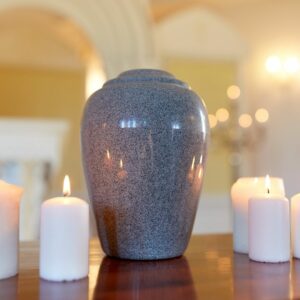Guidance for anyone looking for a Funeral Cremation Urn

Cremation Urns today are available in a wide variety of styles, materials and designs and, given that, it is somewhat surprising that the most popular urns of today still retain the classic, vase-like, look of those made thousands of years ago by the Ancient Greeks.
In an age when technology has allowed urns to be fashioned into an array of unique molds (motorcycle gasoline tanks for the cycling enthusiasts, footballs for sports fans, and even nature scenes for the environmentally conscious), it seems ironic that the traditional look is still the most common.
Indeed, considering all of the changes that have occurred over the centuries in regard to cremation itself, it seems somewhat odd that cremation urns are even still around at all today. But, alas, cremation urns have weathered the centuries in a great number of ways, and that makes them a human tradition worth celebrating.
Perhaps the most obvious way that cremation urns have weathered the ages is through their literal survival of the elements. Archeologists routinely uncover fully intact urns buried among the relics of ancient societies all across the globe.
These urns are usually adorned with symbols and designs that give historians great insight into the way of life of people who lived even before history was routinely recorded in writing.
These ancient works of art are often made of clay, wood, stone or even metal, just as are the urns of today, and, because of the sturdy construction has typically protected the ashes so well, scientists have recently made an interesting discovery.
By putting the biologists’ microscope to the ancient ashes, experts can, possibly, learn something of the physical nature of these ancient men. Analyzing ashes uncovered in ancient urns can, perhaps, lead to much information about the evolution of man’s bone structure and even deadly ancient diseases. But that’s just the start of how urns have weathered the ages.

Urns have survived many important changes in cremation itself over the years. Cremation has long been controversial among the religious, and, in many faiths, it has been outlawed for centuries at a time.
Today, though, most modern religious have fully accepted cremation as an orthodox, even healthy, way of disposing of a body and, of course, the traditional cremation urn continues to be where cremation ashes are commonly stored for the ages.
Aside from surviving the changes in religious attitudes toward cremation, urns have also weather changes in technology that have dramatically changed the cremations are performed. The first cremations were done over large outdoor fires.
A body was placed in a fire-proof container (such as a stone box) that was heated until all that was left was ashes (which are really tiny fragments of bone). Today’s cremations are done indoors and there is usually no direct fire involved. Instead, a body is placed in a large, usually electrically powered “oven” and heated until only ashes remain.
Given the dramatic change in how cremations are performed today, it is somewhat surprising that, well, the urn did not change in an equally dramatic fashion.
While it is now possible to buy urns that are as unique as the personality of the people whose remains they house, it seems safe to say that the classic shape and look of the type of urns used thousands of years ago will never quite go out of style.